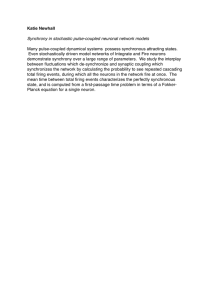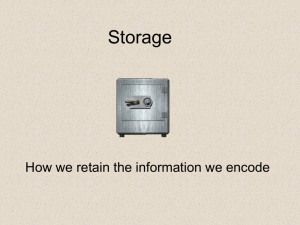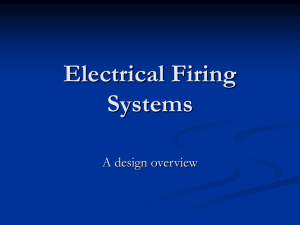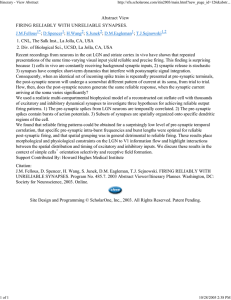LIDS-P-1639 JANUARY 1987 by
advertisement
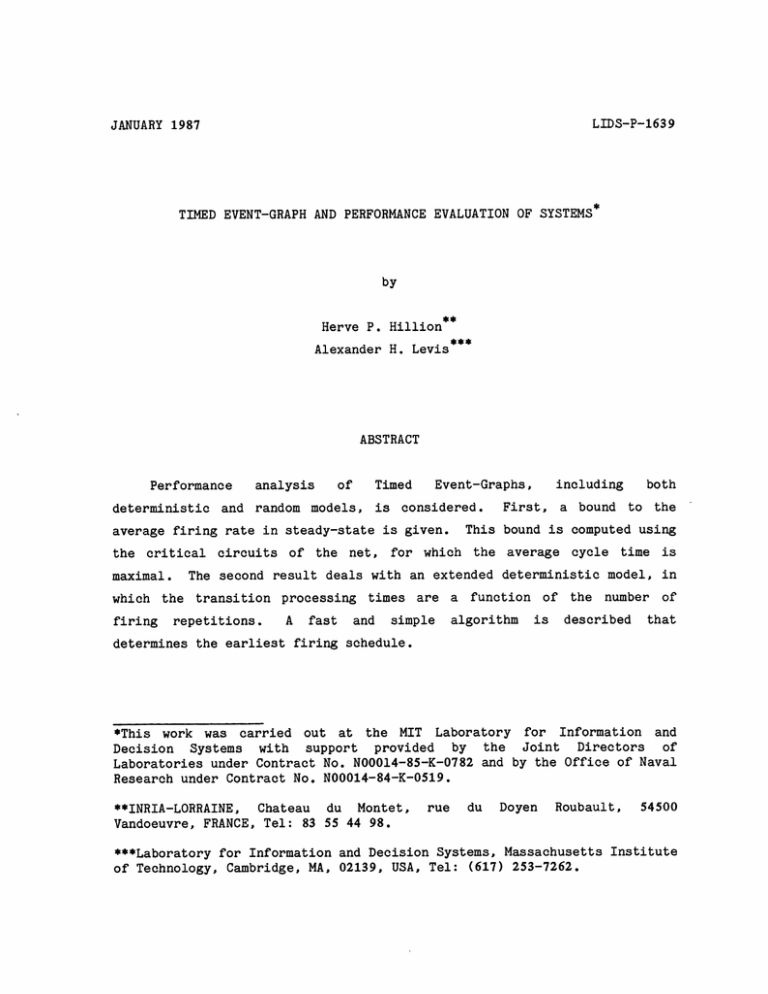
LIDS-P-1639
JANUARY 1987
TIMED EVENT-GRAPH AND PERFORMANCE EVALUATION OF SYSTEMS*
by
Herve P. Hillion
Alexander H. Levis
ABSTRACT
Performance
deterministic
and random models,
is
considered.
critical
firing
the net,
to the
for which
the
average
cycle
time
is
The second result deals with an extended deterministic model, in
maximal.
which
circuits of
a bound
First,
This bound is computed using
average firing rate in steady-state is given.
the
both
including
Event-Graphs,
Timed
of
analysis
the
transition processing times are
repetitions.
A
fast
and
simple
of
a function
algorithm
is
the
number
described
of
that
determines the earliest firing schedule.
*This work was carried out at the MIT Laboratory for Information and
of
Decision Systems with support provided by the Joint Directors
Laboratories under Contract No. N00014-85-K-0782 and by the Office of Naval
Research under Contract No. N00014-84-K-0519.
Chateau du Montet,
**INRIA-LORRAINE,
Vandoeuvre, FRANCE, Tel: 83 55 44 98.
rue
du
Doyen
Roubault,
54500
***Laboratory for Information and Decision Systems, Massachusetts Institute
of Technology, Cambridge, MA, 02139, USA, Tel: (617) 253-7262.
1.
INTRODUCTION
Timed Petri Nets are used to analyse the dynamic behavior of systems
So far, two models of Timed
with asynchronous and concurrent processing.
[1,2,3] in which the
deterministic models
Petri Nets have been studied:
transition firing times are assumed to be fixed, and probabilistic models
[4,5,6], where the firing times are specified by probabilistic distribution
functions,
assumed
generally
be
to
distributions.
exponential
In
both
A
cases, methods are developed to evaluate the steady-state performance.
The transition firing
more general approach is proposed in this paper.
times are considered to be dependent on the number of firing repetitions.
The method
can handle a
the
transition, assuming
firing
times
be repetitive over
time.
sequence of successive
firings to
for
every
The only
exist for each
other necessary assumption is that an average firing time
transition, regardless of any other assumption concerning the sequence of
repetitive
firings
which
may
either
be
deterministic
analysis is restricted, however, restricted to
Nets,
namely
Event-Graphs
[7]
and
focused
is
or
random.
The
a special class of Petri
on
obtaining
performance
measures. The results presented in this paper have been used to evaluate
the performance of Decisionmaking Organizations modeled by Petri Nets [8].
This paper is divided in five sections.
of
the
model,
called
Repetitive
Timed
In Section 2, the assumptions
Event-Graph,
are
presented.
In
Section 3, an upper bound to the average firing rate is computed, that only
depends on the average firing times of the transitions.
deterministic
case is
considered
and a
fast
determines the firing schedule is described.
and
In Section 4, the
simple
algorithm
that
Finally, concluding remarks
are given in the last section.
2.
REPETITIVE TIMED EVENT-GRAPH
Recall first that an Event Graph [7]
is a Petri Net
output
[9]
transition.
(also known as Marked Graph [10])
such that each place has exactly one input and one
Given an initial distribution of tokens in the net
2
(i.e., an initial marking), it is shown in [10] that an Event-Graph is live
if and only if the number of tokens in every directed elementary circuit is
We assume here that this condition is satisfied so that
strictly positive.
each transition can fire repeatedly any number of times.
In Timed Petri Nets, each transition t takes a
When
fire.
t
a transition
enabled,
is
a
firing
wreal"
can
be
time
i(t)
to
initiated
by
The tokens
removing one token from each of t's input places.
transition t for the firing execution during the time
i(t)
remain in
and then the
firing terminates by adding one token in each of t's output places.
Different
models
of
Timed
Petri
Nets
have
been
studied;
in
deterministic Timed Petri Nets [1.2] and Timed Event-Graphs [3], a positive
is
number
(rational)
assigned
defines the firing time g(t).
are
times
assumed
to
be
to
each
t
transition
of
net,
the
which
In stochastic Petri Nets [4,5], the firing
random
variables
that
are
exponentially
distributed.
In this paper, the transition firing times are not fixed, but may be
different from one firing to the next.
firing
times
Therefore, a sequence of successive
{pt(1),pt(2),...,Pt(k),...}
(for
any
transition
constructed according to the number of firing repetitions.
t)
is
There is no
assumption regarding this sequence, except that the following limit
n
2
Lim
n -3)
Pt(k)
(1)
k=lnt
must exist and be finite (for any transition t).
determines the average (or mean)
The limit, denoted by it'
firing time of transition t. Two cases
will be considered.
First,
in
the
non-deterministic
3
case,
the
sequence
of
successive
firing times can be regarded as possible outcomes of the random variable
Pt' with mean value jt (regardless of the probability distribution
function).
For instance, Pt can be a discrete random variable that takes
on a finite set of possibles values {v1 ,v2,...,vj } according to a certain
probability distribution {¥y,...,yj).
In that case:
j
Yk Vk
It=
k=1
This
evaluate
the
performance of Decisionmaking Organizations modeled by Event-Graphs.
In
that
assumption was
model,
the
used by
processing
of
the
a
first author
task
can
be
an
algorithm
distribution:
is
selected,
to
performed
algorithms, each having a fixed execution time.
task,
[81
by
different
At each occurence of the
according
to
a
fixed
probability
such a decision rule is called a decision switch [11] in the
Petri Net model.
The
second
case
is
the
deterministic
case,
successive firing times is assumed to be fixed
Flexible
Manufacturing
machines [12].
Systems,
for
when
the
sequence
(for all transitions).
instance,
transitions
can
of
In
model
If it is assumed that a machine can process different types
of jobs, according to a given sequencing of the jobs, then the sequence of
successive processing times is fixed.
In order to study the performance of Event-Graphs, it is assumed in
this
paper
that
the
Event-Graph
model
is
strongly
connected
and
live.
These assumptions ensure that the transition firings can be repeated any
number of times and that the net is bounded [13].
The following notation
will be used:
T = [tx1 ,t2,.,tm}
is the set of transitions
Pi(n) denotes the n-th firing time of transition ti
(i.e., when ti fires for the n-th time)
4
Si(n) denotes the instant at which the n-th firing
initiation of transition ti occurs.
The initial distribution of tokens (i.e., an initial marking) is given
at v = 0 and is denoted by M O .
be
will
described
also
be
by
The dynamic behavior
of
the
system
will
the sequence Si(n) for i=1,2,...,m and n=1,2,..., which
called
the
firing
schedule.
Since
it
is
assumed
that
transitions fire as soon as they are enabled, the performance obtained is
the maximum performances
(with respect to time) and the schedule is the
earliest firing schedule.
3.
PERFORMANCE EVALUATION
In this section, an upper bound to the performance in steady-state is
obtained.
The performance measure considered is the average period ni with
which any transition ti fires, i.e.,
n
\
n. =
1
Quite
(Si(k) - S i(k-1))
k=!
1
Lim
n-
n -b
obviously,
transition ti.
l/7i
1
1
(2)
n
determines
also
the
average
firing
rate
of
The average period ni can also be written as:
S.(n)
,.
1
=
Lim
n -be
1
(3)
n
Since the Event-Graph is assumed to be strongly connected, the average
period is the same for all transitions of the net and will be denoted by n.
This is trivially deduced by the fact that the number of tokens in any
directed elementary circuits is invariant with any transition firing [10].
A directed elementary circuit is a directed path that goes from one node
(place or transition) back to itself and such that none of the nodes are
repeated.
5.
The average cycle time of any directed elementary dircuit p, denoted
by
C(p),
is
defined
as
the
sum
of
the
average
firing
times
of
all
transitions belonging to the circuit divided by the number of tokens in the
circuit
C(p)
Let
Cmax
be
(4)
= ip
the maximum
average cycle times.
C
max
over all directed
elementary
circuits
of
the
Cmax will be called the maximum average cycle time.
= max
(C(p))
(5)
p
Then the following result holds:
Theorem:
The maximum average
cycle time is
a lower
bound of
the
average period, i.e.,
>~ C
max
(6)
This theorem generalizes
in
which
the
result
all transition firing times
this result,
obtained
by
are constant.
Ramchandani
[1]
In order to prove
we consider any directed elementary circuit p and prove that
n > C(p).
Proof:
Let p be any circuit of the net, that we denote, without loss
in generality,
marking
of
by p =
place
Pi.
(t1
If
Pr
P1
t2...tr
we
consider
)
any
Let M0
two
denote
the
transitions
initial
(ti,ti+1 )
connected by place Pi, then for any positive integer n, we know that (see
[1,3]).
Si+ (n+M )} > S(n) + pi(n)
(7
This means that at the instant:
C = Si(n) + gi(n)
transition ti has nproduced' exactly n tokens in place Pi
fired
exactly
n
times
since
the
initial
instant).
(since ti has
Since
there
were
initially M9 tokens in this place, the total number of tokens available in
Pi during the interval of time [O,zl,
that
is precisely n + M2.
the firing of ti+ 1 was initiated, one
Now, each time
token in Pi was
"consumed".
Accordingly, the number of firing initiations of ti+ ! during the interval
[O,v] cannot be more than (n + Mi ):
Si+l (n+M)
i
1+
Suppose now
that
>
r
i
= S (n) +
1
for i = 1,2,...,r.
n is large enough so that n > M
Then (7) can be written as:
Si+ l (n) > S.(n-M?) +
Wi(n-Mi)
for
i=1,2,...,r
(8)
If we apply recursively (8) from i = r to i = 1, we obtain:
r
S(n)=S
=
(n)
S(n-Nt) +
I((n-M)
(9)
i=l
where Nt denotes the total number of tokens in the circuit, as determined
by:
7
r
MO
Nt =
i=l
Let us now write n in the form:
n = K Nt +s
O~s<N
0 < s <t Nt
Then, we deduce from (9):
K
r
S1 (n) > S(S) +
k=1
li(KNt+s-M
0)
(10)
(10)
i=1
Applying (10) for s = 0,1,2,...,Nt-1 and summing the inequalities yields:
Nt-i K
Nt-1
Nt-l
1(s) +
S1 (KN +s) >
(
s=0
s=0
s=0
k=1
r
KNt-1
r
(
i
+s-Mt)))
(11)
i=1
Now:
Nt-1 K
E( I
s=0
r
(
gi(kNt+S-M0 )
) )
=
k=1 i=1
Finally, dividing
I
(
I
i(q+Nt-M))
i=1 q=O
(11) by KNt and
infinity, we obtain
8
taking the limit when K goes
to
(1)
lim
K-
Nt-1
(S
(KNt+S))
1
s=O
1
t
Nt-1
s=O
S (KN +s)
(lim
t
=N
tKN t
Kgiven (3)
Nt-1
0
(2)
lim
r
K-
s
1
i
KNt
r
s (S)(S
(li
N
=
t
s=O
K-
KNt-1
Kt i2
2
K
KN-~ co
i=1 q=O
(
-
t
=
=tii
~
r
ii(q+Nt-M i)))
i
=
n-l
2
(lim 1 ( pi(q+Nt-MO)))
n- c n
i
i=i
q=O
given (2)
i=1
Hence:
r
Nt n ->
i
i=l
which implies:
r
ii
T
n > i=1
Nt
=C(p)
Q.E.D.
The result obtained in Theorem 1 gives an upper bound to the average
firing rate, since (6) can be written:
9
This
C
bound
determined.
(12)
1
max
<
!
-
can
be
quite
computed
easily,
once
all
circuits
are
A simple method for obtaining all circuits is described in
[8], using an algorithm that determines the invariants of a net [14].
It
is particularly interesting that the upper bound of the maximum performance
only
of
depends
the
transition mean
firing
times
(given the
initial
distribution of tokens), regardless of any other assumptions concerning the
firing times (which may be either deterministic or random variables with
any type of probability distribution).
Recall that (12) is shown to be an
equality (i.e., n = Cmax) when the transition firing times are constant
[1], and that the steady-state is then K-periodic [3].
In computing Cmax, it is also interesting to determine the critical
circuits, i.e., those circuits p for which C(p) = Cmax.
only
these
circuits
bound
the
average
firing
rate
It turns out that
in
steady-state.
Accordingly, the critical circuits should be the ones to modify (in terms
of transition firing times or number of tokens in the circuit) so as to
improve the performance of a system.
We are now going to determine the firing schedule, assuming that the
sequences of successive firing times are known, i.e., the firing process is
deterministic.
4. DETERMINATION OF THE FIRING SCHEDULE
We present in this section a fast algorithm to compute the firing
schedule, i.e., the sequence (Si(n)) i=l,...,m ; m=1,2,..., when the system
is deterministic.
An initial distribution of tokens is assumed to be given
at v = 0 and the sequence of successive firing times Hi(n) n=1,2,... is
assumed to be fixed for any transition ti.
with which transitions fire.
10
We first determine the order
4.1
Partial Firing Order
Given the structure of the net and the initial distribution of tokens,
some transitions fire sequentially and other fire concurrently.
In order
to psecify how the firings occur in the process, we proceed as follows.
call marked places the places which contain one token.
We
We first consider
the set P1 of places that contain at least one token, i.e., with an initial
marking strictly positive, and take this set as the initial set of marked
places.
Then let T1
places of P1 .
be the
set of transitions that are enabled by the
Assume that all transitions of T1 fire once and let P 2 be
the new set of marked places.
Let T 2 be the set of transitions that are
enabled by the places of P 2 and which do not have already fired (i.e., do
not belong to T1 ).
of T2
have
transitions
Let P3 be the set of marked places once all transitions
fired.
In a
that are
similar way,
we
Ts+,=O.
consider
the
enabled by P 3 and which do not have
(i.e., do not belong to TOUT2 ) and so on.
until
then
Because
the
net
is
a
set T3
of
already fired
We repeat this operation s times
live
Event-Graph,
the
sequence
TL,T2,...,T s so constructed verifies:
T = T 1 U T 2 ...U T S
where T
denotes
determines
firings.
the
set of all transitions of
therefore
the
partial
firing
order
the
between
In particular, the transitions belonging to T i
transitions that fire concurrently at the i-th step.
sequence
net.
T,T
transitions.
2 ,...,
Ts
will
be
called
the
This sequence
the
transition
(i=l,...,s)
are
For that reason, the
sequence
of
concurrent
It should be clear that this sequence is fully determined by
the structure of the net, and the initial distribution of tokens.
4.2
Firing Schedule
For clarity, we now assume that the transitions are labeled according
to the sequence Tl,...,Ts, i.e.,
11
T1 = ftl ,t , ..
tk }
T1 =
= ft
f t,tkl}
T
t
k '+2
tk 2 }
Ts = {tks+"'--- tm
where m denotes the total number of transitions in the net.
Note that the
order between the transitions belonging to Ti (i=l,...,s) does not matter,
since the transitions fire concurrently.
For
any
transition
tj
we
now
denote
by
Inp(tj)
the
set
of
all
transitions which are the input transitions of all input places of tj, as
shown on Figure 1;
and
{pil'Pi2,...'Pir} are all input places of transition tj
({ti,ti
2 ,...,tir}
places.
is the
set of input
transitions
of each of
these
If ti e Inp(tj), we also denote by Mij the initial marking of the
unique place Pij whose input transition is ti and output transition tj.
ti1
ti2
pi2
pir
-
tir
Figure 1.
Definition of Inp(tj)
For any transition tj and any transition ti 8 Inp(tj) we have:
Sj(n+Mi)
>
Si(n) + ~i(n)
(13)
12
where n is any positive integer.
(7)(see previous section).
The inequality follows directly
Suppose that n > M9
1j3
from
Then (13) can be written
as:
0
Sj(n) > Si(n-Mij) +
For simplicity, let
0
(14)
gi(n-Mij)
us assume Si(k) = 0 and gi(k) = 0 if k < 0 (for
i=1,2,...,m), so that (14) is still satisfied if n
MJ:
this means that
there are still tokens left in the place Pij from the initial marking, so
that the firing initiations of tj do not depend on the firing terminations
of ti.
Given the assumption that the firings occur as soon as the transitions
are enabled, we deduce from (14) the following relation:
S (n)
max
(Si(n-Mii) +
i(n-Mij))
(15)
t.ieInp(t.)
j
Equation (15) can now be used to compute the firing schedule by iteration
on n, the number of firing repetitions.
compute Sj(n)
(j=1,2,...,m)
At the n-th iteration,
once we know both Si(k)
k=1,2,...,n-1 and Si(n) for i=1,2,...,j-1.
t
i
e Inp(tj)
interation).
If Mi
T1 ,T 2 ,...,T s,
for i=1,2,...,m and
Consider indeed any transition
> 0, we then know Si(n-M 9 j) (computed at a previous
Now if MOj =,
necessarily fire
we can
before
it follows
tj.
it means that in the firing order ti should
Therefore
that i < j.
if tj a T1 then, by the sequence
Finally,
if
tj
e T1
then,
construction, MOj is always strictly positive whenever ti 8 Inp(tj)
The algorithm can now be described recursively in a very simple way:
13
by
(Initialization}
p = Max (Mij)
for k = -p to 0 set Si(k) = 0 and gi(k) = 0
{for i=l,...,m}
n=1
Repeat {main loop}
For j = 1 to m
Sj(n) =
set
0
max
(Si(n-Mij) +
t.sInp(t.)
i
0
Ii(n-Mij))
End
until n = N (total number of firing repetitions).
Recall that there are two steps to complete in order to use the algorithm:
(1)
Determine
the
firing order
of
the
transitions,
following
the
method described in Section 4;
(2)
Determine the set Inp(tj) for any transition tj (deduced from the
structure of the net).
This
algorithm
Decisionmaking
has
been
Organizations,
should be noted that, in this
used
to
using a
compute
Timed
the
firing
schedule
Event-Graph model
[8].
of
It
approach, we do not need to describe the
states of the system nor use graph
theory (as is
done in the algorithm
proposed in [3] for constant firing times).
5.
CONCLUSION
We have developed in this paper some techniques for analyzing realtime systems that can be modeled using Event-Graphs.
The result presented
in Section 3 generalizes the result obtained in [1] for constant transition
firing times.
It can be used for preliminary performance evaluation of a
14
general system for which only the average task execution times are known.
It
holds,
in
probabilistic
particular,
models
without
studied
so
the
restrictive
far.
We
have
assumptions
also
of
extended
the
the
deterministic case, allowing a different firing time at each repetition.
The algorithm described in section 4 provides a simple way to obtain the
precise firing schedule for this case without the need for simulation.
REFERENCES
[1]
"Analysis of asynchronous concurrent systems
Ramchandani, C. (1974).
by Timed Petri Nets", Technical Report No. 120, Laboratory for
Computer Science, MIT, Cambridge, MA.
[2]
"Performance Evaluation of Systems using Nets",
Sifakis, J. (1980).
Net Theory and Applications, Lecture Notes in Computer Science,
Springer-Verlag, Berlin, FRG, pp. 307-319.
[3]
"Modeling scheduling problems
Chretienne, P. and Carlier, J. (1984).
with Timed Petri Nets," Advances in Petri Nets, 1984, Lecture Notes in
Computer Science, No. 188, Springer-Verlag, Berlin, FRG, pp. 62-82.
[4]
"M-Timed Petri Nets, priorities, preemptions,
Zuberek, V. M. (1985).
and performance evaluation of systems," Advances in Petri Nets, 1985,
Lecture Notes in Computer Science, No. 222, Springer-Verlag, Berlin,
FRG, pp. 478-498.
[5]
"Performance analysis using stochastic Petri
Molloy, M.K., (1982).
Nets," IEEE Trans. on Computers, Vol. 31, No. 9, pp. 913-917.
[6]
Wiley, R.P. (1986). "Performance analysis of stochastic Timed Petri
Nets," Ph.D. Thesis, Report LIDS-TH-1525, Laboratory for Information
and Decision Systems, MIT, Cambridge, MA.
[7]
Brams, G.V. (1983).
Paris, France.
[8]
"Performance evaluation of Decisionmaking
Hillion, H. P. (1986).
Organizations using Timed Petri Nets," M.S. Thesis, Report LIDS-TH1590, Laboratory for Information and Decision Systems, MIT, Cambridge,
MA.
[9]
Peterson, J. L. (1981). Petri Net theory and the modeling of systems,
Prentie-Hall, Englewood Cliffs, NJ.
Reseaux de Petri:
theorie et pratique, Masson,
"Marked
[10] Commoner, F., A. W. Holt, S. Even, and A. Pnueli, (1971).
Directed Graphs," Journal of Computer and System Sciences, Vol. 5, No.
5, pp. 511-523.
15
"Petri Net representation of
[11] Tabak, D. and A. H. Levis (1985).
decision models," IEEE Trans. on Systems, Man and Cybernetics, Vol. 5,
SMC-15, No. 6, pp. 812-818.
[12] Cohen, G., D. Dubois, J.P. Quadrat and M. Viot (1985).
"A linearsystem theoretic view of discrete event processes and its use for
performance evaluation in manufacturing," IEEE Trans. on Automatic
Control, Vol. Ac-30, No. 3, pp. 210-220.
of Petri Nets,"
"Structural properties
[13] Sifakis, J. (1978).
Mathematical Foundations of Computer Science, Lecture Notes in
Computer Science, No. 64, Springer-Verlag, Berlin, FRG, pp. 474-483.
[14] Martinez, J. and M. Silva (1980).
"A simple and fast algorithm to
obtain all invariants of a generalized Petri Net," Lecture Notes in
Computer Science, No. 52, Springer-Verlag, Berlin, pp. 302-310.
16

